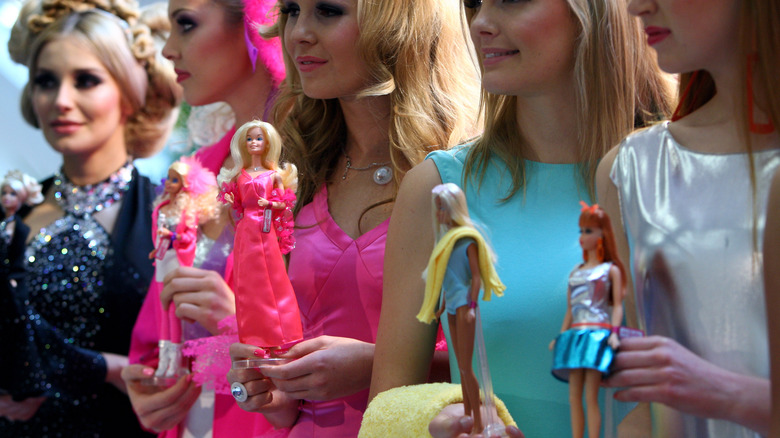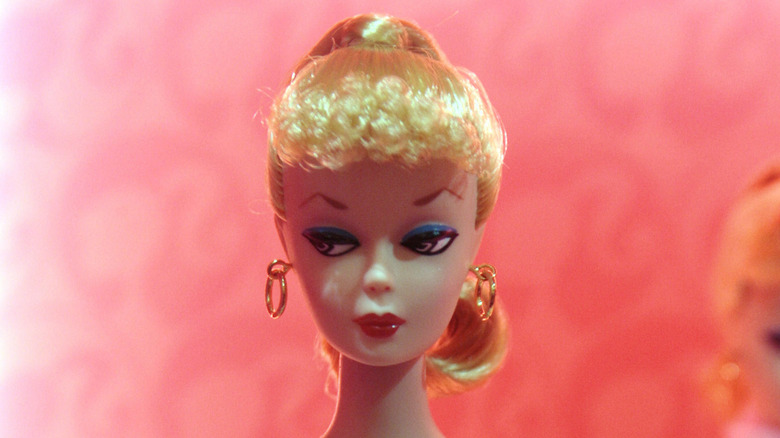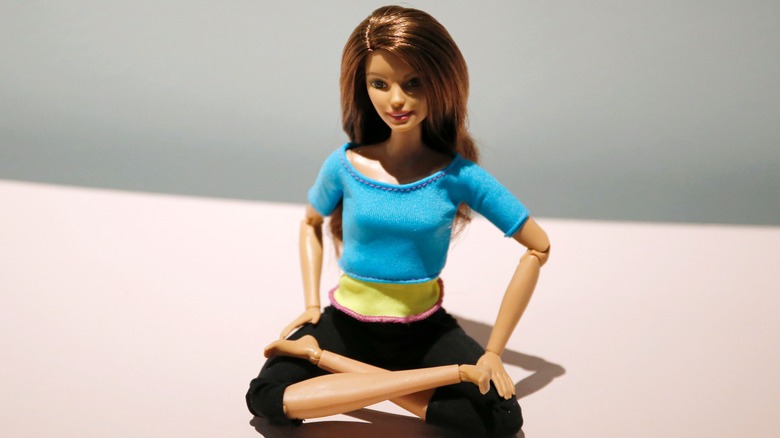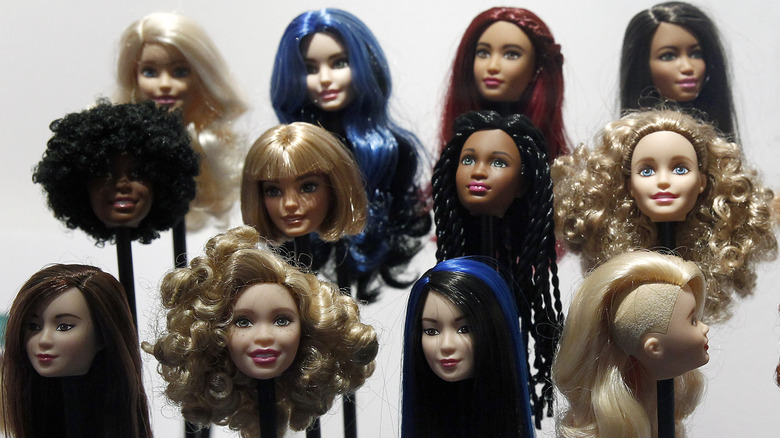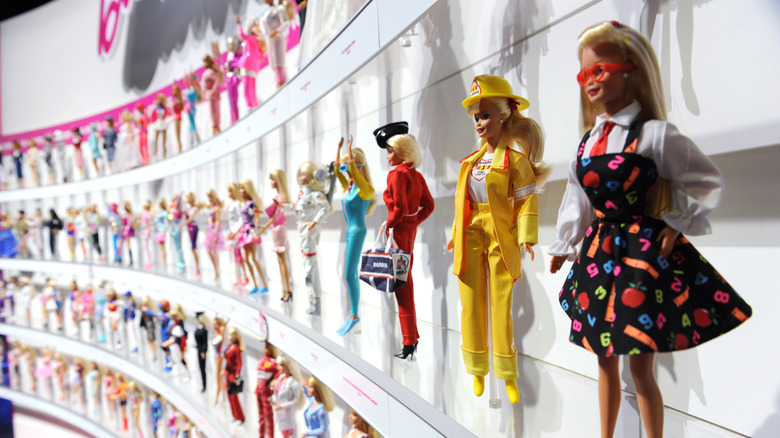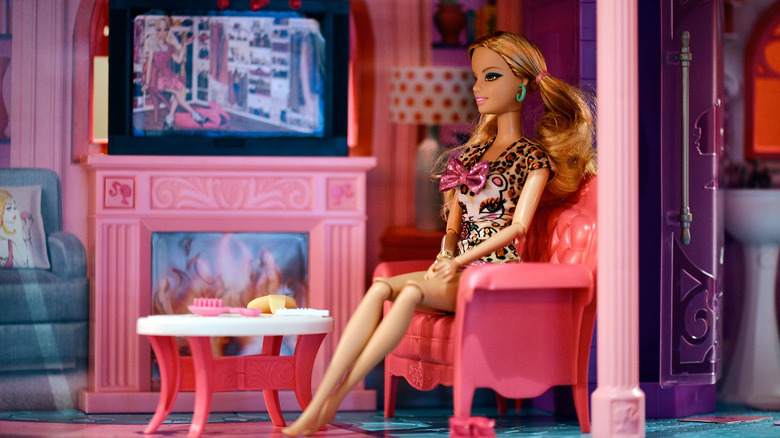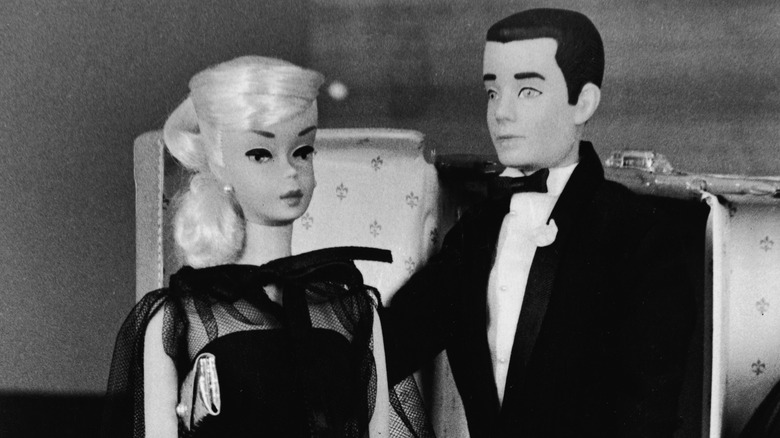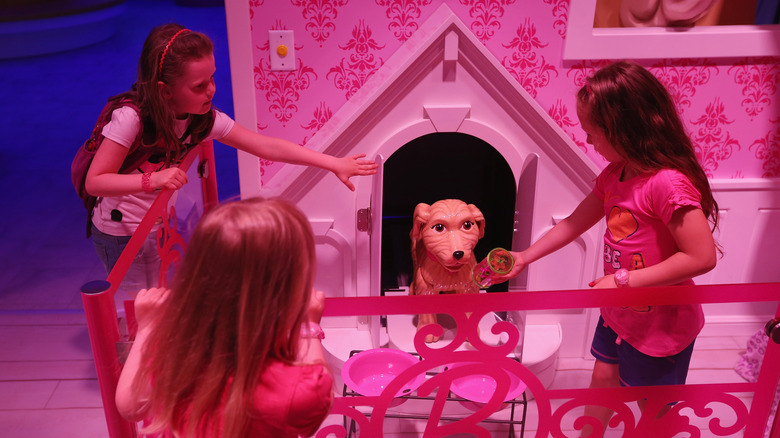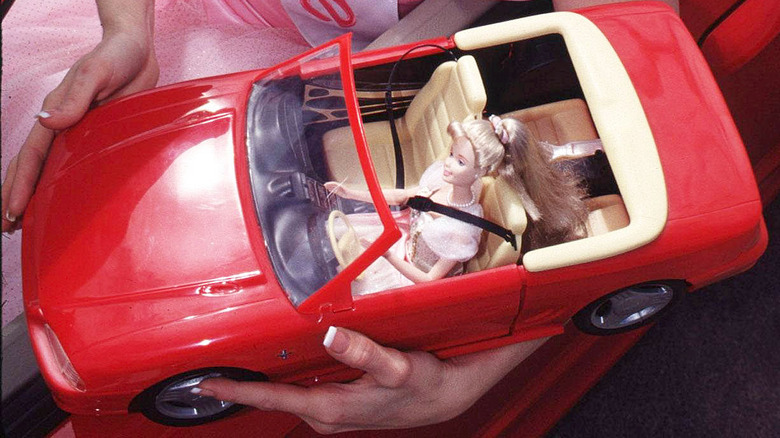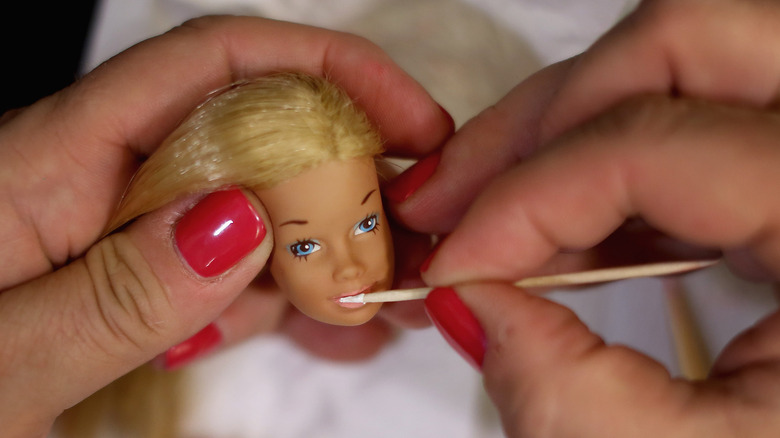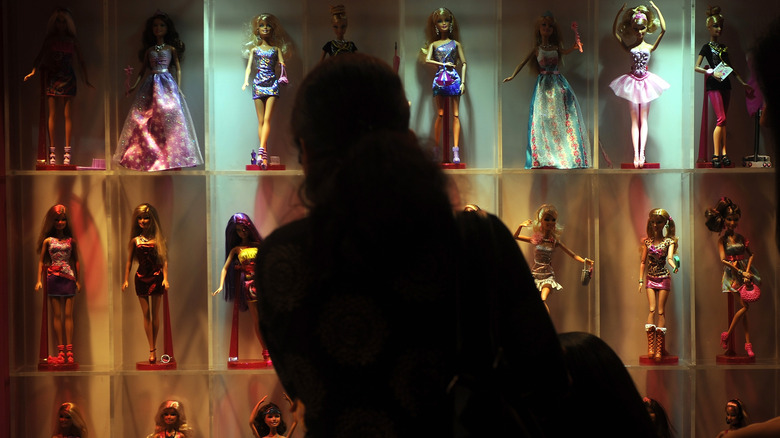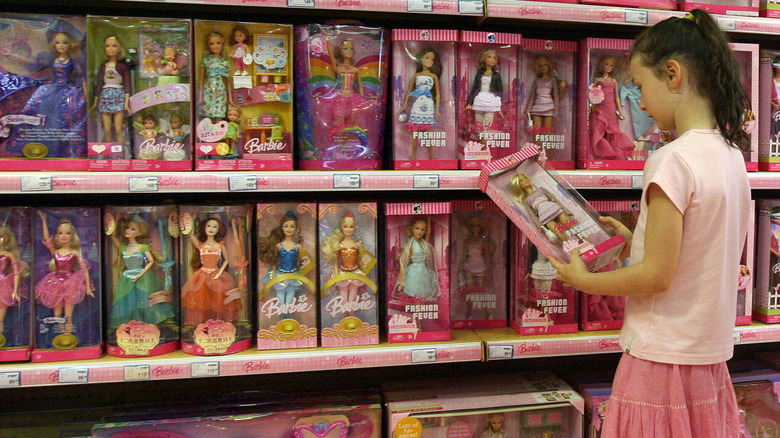Things About Barbie You Only Notice As An Adult
Do you remember picking out your first Barbie? There was so much excitement standing in the Barbie aisle of the toy store: scrutinizing each doll, reading the front and back of the bright pink rectangular box that housed her, and — after presenting your convincing argument to your mother — placing Barbie in the shopping cart.
When you were young, you probably were not aware of the scrutiny the Barbie doll and her creator, Ruth Handler, received. Many parents objected to the doll and, despite becoming a very successful toy in the end, was heavily criticized by feminists, among others.
Responding to the backlash, Handler said in an interview with Lilith Magazine, "I understood the need of little girls to project themselves into their dreams." Handler also added, "The fact that Barbie is so loved speaks for itself."
Does it, though? Here are some things you may not have noticed until long after you stopped playing with Barbies.
Barbie is a teenager with a mom's name
When you were little, you most likely didn't think much about the doll's name: Barbie. As a child's network of contacts doesn't exactly extend far beyond neighbors, immediate family, and childhood friends, it's possible you didn't know any other Barbies growing up. It's also entirely possible that you thought Barbie was just what that specific doll was called and not a name at all.
Barbie creator and Mattel founder Ruth Handler explained in an interview, "I knew that I had to name the doll after my daughter, who had really inspired the entire project. So, we named the doll Barbie."
Barbie, short for Barbara, was an incredibly popular name at the time the doll came into existence. According to the Social Security Administration's record of top baby names, Barbara was the third most common name for girls born between 1930 and 1949. By 1959, the year the Barbie doll was invented, the name Barbara was still in the top ten — number six to be exact.
However, if you are of the millennial generation and were playing with Barbies in the 90s, you'd have been hard-pressed to meet a real live Barbie or Barbara, at least one that was your age.
While Barbie remains a perpetual teenager, her name has become more and more dated, leading to a really odd mixture of a young woman with a mom's — or even grandma's — identity.
She's had a ton of plastic surgery
As you now know, Barbie is nearly 59 years old. What's her secret to looking so young? Plastic surgery. Tons and tons of plastic surgery.
All jokes aside, in an interview with the San Francisco Chronicle, Sean Fitzgerald, vice president of corporate communications for Mattel, explained changes to the Barbie doll. Between 1959 and 1997, she went through three new faces, received bendable knees and elbows, and even an opposable thumb.
In the fall of 1998 came even more radical plastic surgery: smaller hips, reduced bust size, wider waist, and flat feet. Barbie also stopped smiling with teeth in favor of a closed-mouth grin and her luscious locks became straighter and more three-dimensional as different shades were incorporated.
Why all the changes? Fitzgerald further explained, "They [target audience of girls ages 3-11] wanted Barbie to be cooler. They wanted Barbie to be more reflective of themselves."
It might be hard to imagine that preschoolers would picture themselves as young adult Barbies, but nevertheless, Fitzgerald explained the "significant evolution" of Barbie is "part of the doll's history." He added, "We're keeping it fresh." That is certainly true!
Barbie is freakishly disproportionate
Both before and after her extensive plastic surgery in the late 1990s, Barbie's body remains, well, inhuman. Galia Slayen, author of the HuffPost article "The Scary Reality of a Real-Life Barbie Doll," actually made a full-scale replica of Barbie.
It all started with two pieces of wood. After hammering them together, she had a stick figure frame that was roughly six feet tall. Slayen explained the second part of the process, "The chicken wire came next. Surrounding her wooden frame, we created a body that wasn't much thicker than a stick figure, but had the womanly and unattainable curves and proportions that impressionable young girls idealize."
Using balloons and paper mâché for Barbie's bust and solely paper mâché for her skin, Barbie came to life. In the end, "She stands about six feet tall with a 39" bust, 18" waist, and 33" hips," Slayen reported.
While Slayen's Barbie replica fits comfortably in a size 00 mini skirt, the average American woman wears a size 16-18, according to a study by the International Journal of Fashion Design, Technology and Education.
Slayen went on to add even more frightening statistics about Barbie's proportions in her article. Because of Barbie's incredibly low BMI (Body Mass Index), she would fit the criteria for being anorexic. In addition, due to her disproportionate features, she would also need to walk on all fours!
Her hair won't grow back after you cut it
You can admit it. You cut your Barbie's hair just to see what would happen, didn't you? It's okay, we've all been there. Sadly, as it turns out, her hair just doesn't grow back. Perhaps even more cringe-worthy than remembering all the times you Edward-Scissorhanded your dolls' hair is now learning just how much work went into those golden tresses.
In an interview for Los Angeles Times, Stephen Tarmichael told of his special relationship to Barbie. In 1988, Tarmichael, a licensed cosmetologist, became Barbie's official hairdresser. Of course, working with Barbie's hair is vastly different from humans'.
For starters, Barbie's hair is synthetic. It is made from either a fiber called Kanekalon or a type of plastic called hollow saran. Also, Barbie's hair is 'rooted' differently, which makes her locks more voluminous, even before styling. Tarmichael couldn't be expected to style every doll's hair — that would be far too many clients for one person. Instead, he creates a prototype, which is then shipped overseas with "step-by-step styling photos."
Tarmichael further elaborated on his job and reported a glaring difference between his work and the work of a human hair stylist, "We have strict guidelines to make sure Barbies aren't bald. We weigh all the heads."
Tarmichael is also responsible for making sure Barbie's hair is en vogue, which, as the article explained, is difficult considering all hairstyles are selected a year before the doll is expected to arrive at toy stores.
Do you feel like apologizing to your Barbies yet?
She can't seem to hold down a job
With her great/odd bod, professionally styled hair, and responsible-sounding name, you would think Barbie would have no problem finding steady work. No such luck, it seems. Sure, Barbie can get a job, but she just can't seem to stay employed at one place for very long.
In a profile of Ruth Handler, Entrepreneur told of the many professions of Barbie. In 1959, she started out as a teenage fashion model and, by 2008, she had held more than 75 additional positions. That's not to say she's taken that many positions all within the same field, no. She is something of a jack of all trades.
According to Time, she has been employed as an astronaut, rap musician, paleontologist, WNBA player, presidential candidate, and even a Major League Baseball player — for three separate teams: New York Yankees, Chicago Cubs and Los Angeles Dodgers.
How does she find the time?
Her dream house is impressive...ly small
Can you recall the first time you saw the Barbie Dream House? Chances are you looked right past the steep numbers on the price tag and decided the house was an absolute necessity. If you were a 90s kid, the Dream House was rightfully quite amazing. Barbie Dream House circa 1995 had the working elevator which, even your parents would have to admit, was pretty cool.
The first Barbie Dream House from 1960, as depicted in an original commercial by Mattel, was quite different. It featured a large closet to store all of Barbie's clothes as well as a "fashion shop." By 1979, however, Barbie had even more.
An article for HuffPost dubbed it the "six-room mega-dollhouse" and, at four feet long and three feet tall, it isn't hard to understand why. It was also retailing for a whopping $110 in 1960 which, as the article explains, would've roughly equated to $350 in 2012.
Sounds impressive, doesn't it? However, the Dream House was not quite what it seemed. The article continued, asking the chief economist at Movoto to calculate the cost. "A real-life Barbie Dream House located in Malibu, Calif., would cost about $107,000," the article reports.
Before you get too excited, you should know the home is only affordable because of its size: "a laughably small 126-square-foot footprint." Perhaps Barbie was just ahead of her time all these years. Maybe her dream mansion was more of a Dream Tiny Home all along.
Barbie and Ken weren't married when you knew them
Where there is Barbie, there is also Ken.
Ken was introduced just two years after Barbie hit the shelves. Why the name Ken? "The dolls are named for my own children. Barbie and Ken," Handler explained in an interview with Lilith Magazine. So, Barbie and Ken are siblings then? If you know a thing or two about Barbie and Ken's relationship, you may be getting pretty grossed out at this point.
However, it's worth noting that just because Barbie and Ken (the people) may indeed be brother and sister that doesn't mean Barbie and Ken (the dolls) are. No, incest is not being promoted here in the Mattel family.
According to an Associated Press quoting Russell Arons, vice president of marketing at Mattel, Barbie and Ken dated for 43 years. You may have assumed they were married all that time, but that wasn't the case. In 2004 came their shocking decision to split. Arons explained that they "feel it's time to spend some quality time — apart."
What caused the two to part ways after so many seemingly wonderful years together? The article reported that Arons made some hints during his interview that the separation could be because Ken's reluctance to marry Barbie. Gasp. Barbie's ever-changing careers also could have played a role in the divide.
Don't worry, though, because Barbie and Ken ultimately patched things up in 2014.
Barbie has way too many pets
With Barbie's Dream House being especially tiny, Barbie's pad is certainly crowded enough with just Ken and herself. Yet, that doesn't seem to matter much to Barbie. She has filled her home and her life with quite a few pets.
According to Entrepreneur, she has 17 dogs and five cats. Bad news, Barbie. That isn't even legal! In Malibu, California, where Barbie 'lives,' four dogs is the limit. Barbie's five cats, however, may be allowed to stay.
Barbie doesn't just stop at collecting house pets, however. Entrepreneur went on to list her three ponies and 12 horses. It's surprising Barbie hasn't ended up on an episode of Hoarders by now. She's simply out of control!
She's quite materialistic
Despite having had a very modest home in California, Barbie has always been pretty money-driven. Good Housekeeping reported that Barbie upgrades her house every few years. That said, she's never been willing to move away from the west coast as every home is located in Malibu. She likes what she likes, apparently.
Barbie's home upgrades have been pretty spectacular. The 2014 Dream House featured two elevators! Why two? Well, she needed one just to transport her clothes. Obviously. Even more mind-blowing was Barbie's upgrade in 2017 named Barbie Hello Dreamhouse. It is a smart home that can respond to over 100 voice commands. If you thought the elevators from past houses were cool, Barbie's Hello Dreamhouse has an electronic staircase that turns into a slide.
In addition to having the snazziest houses, Barbie also owns more vehicles than she probably knows what to do with. According to motorward.com, her first car was a 1962 two-seater sports car. Since then she's had a Mercedes Benz, Chevrolet Corvette, among others. Apparently, her temporary breakup with Ken led to a "shopping spree" in which she acquired even more vehicles.
Will anything she buys ever be enough?
She's literally always wearing makeup
Barbie is beautiful, but have you ever wondered what she would look like without all that makeup? No doubt she's "naturally" attractive.
Nickolay Lamm, an artist and researcher from Pittsburgh, Pennsylvania, spoke to Today about Barbie's makeup: "I think it's a little bit too hyper-sexualized and I think people don't say anything because makeup has been on dolls for so long."
Lamm, along with another artist, photographed four Barbie dolls and digitally removed their makeup. The result? Barbie is still gorgeous. Lamm continued, "The Barbie... dolls look better, more natural without makeup and I feel that without the makeup, they still look good." He added, "Why don't they sell them without makeup as well?"
Lamm raised a good question and one that Mattel will hopefully answer one day.
She failed to represent diversity
Until very recently, Barbie hasn't exactly been diverse.
Mattel president and COO Richard Dickson argued to Time, "Our brand represents female empowerment. It's about choices. Barbie had careers at a time when women were restricted to being just housewives."
While that's true, Barbie still seems to have failed to represent the everywoman, and instead became a representation of affluent white women. After all, the first true African American Barbie doll didn't hit shelves until 1968, according to Black America Web. Prior to that, Mattel did make an attempt at releasing the first ethnically diverse doll in 1967: a doll called "Colored Francie." However, this Francie was not generally accepted as an accurate African-American representation because she used the exact same mold as a regular Barbie, but was instead just colored brown. Christie, however, came along in 1968 and utilized a new mold that more accurately represented African features, giving her a unique place in history.
Time shared the very telling comment of a mom taking part in a Barbie focus group, "I brought my daughter to a Christmas-tree lighting with Santa and Barbie the other day. If a black woman or a redheaded woman or a heavyset woman had shown up, my daughter would have been like, 'Where's Barbie?'"
Mattel seems to have realized the errors of their ways and is becoming, albeit slowly, more and more representative of diversity. As of 2016, Mattel started selling Barbies with three additional body types — curvy, tall, and petite — and seven more skin tones.
Barbie may have damaged your body image
Barbie, for better or for worse, has been a big part of many girls' childhood memories. The popular dolls are often viewed as safe playthings by parents and favorited by young children across the globe. However, are Barbies truly as harmless as they initially appear?
According to a study on the effect of dolls on the body image of 5- to 8-year-old girls, the answer is no. Or, at least, possibly not.
In this study, a total of 162 girls within the age range of 5-8 years old were shown pictures of either Barbie dolls, Emme dolls, or no dolls at all. They were then asked to complete assessments of body image. The findings indicate that girls exposed to the Barbie doll had "lower body esteem and greater desire for a thinner body shape" than both the group of girls with the Emme doll and the group with no dolls at all.
The study continued, "Even if dolls cease to function as aspirational role models for older girls, early exposure to dolls epitomizing an unrealistically thin body ideal may damage girls' body image."
Wow. Thanks, Barbie! Though, if like me, you gave your Barbie an epic bowl-cut, you can rest a little easier knowing you had the privilege of exacting revenge.
